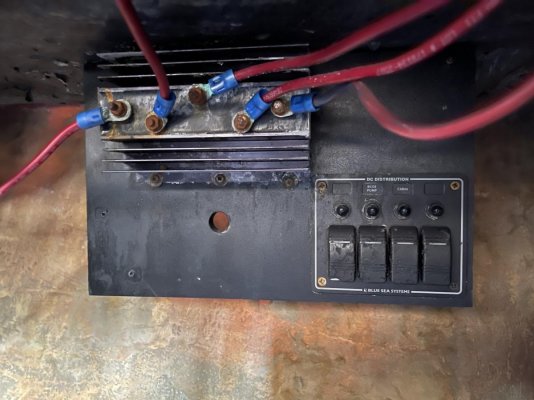You are using an out of date browser. It may not display this or other websites correctly.
You should upgrade or use an alternative browser.
You should upgrade or use an alternative browser.
34 LRC mystery part
- Thread starter CMantra
- Start date
The friendliest place on the web for anyone who enjoys boating.
If you have answers, please help by responding to the unanswered posts.
If you have answers, please help by responding to the unanswered posts.
RT Firefly
Enigma
Greetings,
Welcome aboard. No idea but inverter is a good guess...

Welcome aboard. No idea but inverter is a good guess...
Looks like it may be a batty isolator.
If its wired to the alt output and several battys it splits the charge but prevents drawing other banks down under load. I dont think I have seen one with that many terminals? More commen with 2 or 3 batty connections.
If thats what it is there are many other more modern and better techno,ogres available. Diodes will drop V approx a Volt which can be an issue when trying to charge battys.
If its wired to the alt output and several battys it splits the charge but prevents drawing other banks down under load. I dont think I have seen one with that many terminals? More commen with 2 or 3 batty connections.
If thats what it is there are many other more modern and better techno,ogres available. Diodes will drop V approx a Volt which can be an issue when trying to charge battys.
C lectric
Guru
It is called a Battery Isolator. It uses diodes to separate the alternator output to the battery sets, and prevent/isolate the batteries from discharging into one another.
They do work BUT and in battery charging system this is important that they cause a voltage drop of approx. 0.6V which to our systems is a lot.
THere are lots of work arounds.
But even better are the newer combiners/smart combiners, or ACR.
THese create virtually no Vdrop as they are simply a large relay OR use Mosfets for VERY Low Vdrop to the batteries.
Some electronic controls are used to sense voltage buildup for closing and joining the battery sets
OR
voltage dropping to open thus isolating the battery sets to prevent an unintended discharge.
THis one has two inputs from two alternators and three outputs to three batteries.
They do work BUT and in battery charging system this is important that they cause a voltage drop of approx. 0.6V which to our systems is a lot.
THere are lots of work arounds.
But even better are the newer combiners/smart combiners, or ACR.
THese create virtually no Vdrop as they are simply a large relay OR use Mosfets for VERY Low Vdrop to the batteries.
Some electronic controls are used to sense voltage buildup for closing and joining the battery sets
OR
voltage dropping to open thus isolating the battery sets to prevent an unintended discharge.
THis one has two inputs from two alternators and three outputs to three batteries.
Comodave
Moderator Emeritus
- Joined
- Jul 2, 2015
- Messages
- 21,287
- Location
- Au Gres, MI
- Vessel Name
- Black Dog
- Vessel Make
- Formula 41PC
And a lot of corrosion going on. Also the connections look suspect.
- Joined
- Jan 9, 2014
- Messages
- 4,180
- Location
- USA
- Vessel Name
- N/A
- Vessel Make
- 1999 Mainship 350 Trawler
A battery combiner with 5 small lugs and a variety of wire sizes?? It looks like a simple positive bus bar with a heat sink to dissipate heat. My guess is the main lead comes in from the battery to the bus bar. I'd guesss there is in internal or backplane connector to the switches. You can wire devices to the devices or hard wired DC devices directly into the bus bar (Though I would expect to see inline fuses on the wires from a bus bar.
High Wire
Guru
As C Lectric says it’s a battery “isolator” which was popular back in the 70’s and 80’s to charge multiple battery installations from a single alternator. This was before “combiners “ and “voltage sensing relays” arrived on the marine market.
- Joined
- Apr 15, 2008
- Messages
- 13,731
- Location
- California Delta
- Vessel Name
- FlyWright
- Vessel Make
- 1977 Marshall Californian 34 LRC
C lectric knows his stuff! I'd listen to him...and chuck that into the bilge as ballast when you install an ACR/combiner.
CMantra
Member
- Joined
- Feb 8, 2021
- Messages
- 11
- Vessel Name
- Metta
- Vessel Make
- Californian 34 LRC
Thanks for the help!
I will definitely have to look into updating it as I’d planned to add solar at some point anyway. The more I get into the electrical on this boat the more I realize that it needs more work than originally suspected. My surveyor told me up front I’d need a marine electrician to sort out whatever the previous owner’s dad (a retired marine electrician) did. I’m finding now the more that I trace wires and check panels and continuity that instead of repairing a lot of the electrical that started to get wonky, he just added new stuff and bypassed all the old stuff and left the old stuff there and only if he needed it for fishing (which was his main use for the boat). A lot of the liveaboard amenities weren’t part of that list which is frustrating cause I’m living on it. I’m finding lots of disconnected, unterminated wires still throughout the boat.
I will definitely have to look into updating it as I’d planned to add solar at some point anyway. The more I get into the electrical on this boat the more I realize that it needs more work than originally suspected. My surveyor told me up front I’d need a marine electrician to sort out whatever the previous owner’s dad (a retired marine electrician) did. I’m finding now the more that I trace wires and check panels and continuity that instead of repairing a lot of the electrical that started to get wonky, he just added new stuff and bypassed all the old stuff and left the old stuff there and only if he needed it for fishing (which was his main use for the boat). A lot of the liveaboard amenities weren’t part of that list which is frustrating cause I’m living on it. I’m finding lots of disconnected, unterminated wires still throughout the boat.
CMantra
Member
- Joined
- Feb 8, 2021
- Messages
- 11
- Vessel Name
- Metta
- Vessel Make
- Californian 34 LRC
Until I’m able to replace the combiner, would it be an appropriate place to hook a solar trickle charge to so I don’t have to run my engines or generator daily. I really hate burning diesel if I don’t have to, especially since I’m in south Florida and the sun is abundant more often than not. I’m about to kill my power and go clean the terminals on the combiner cause it needs to be done. I’m just trying to think of ways to get by until I can line up the haul out and tackle all this electric with an overhaul
Similar threads
- Replies
- 3
- Views
- 213

